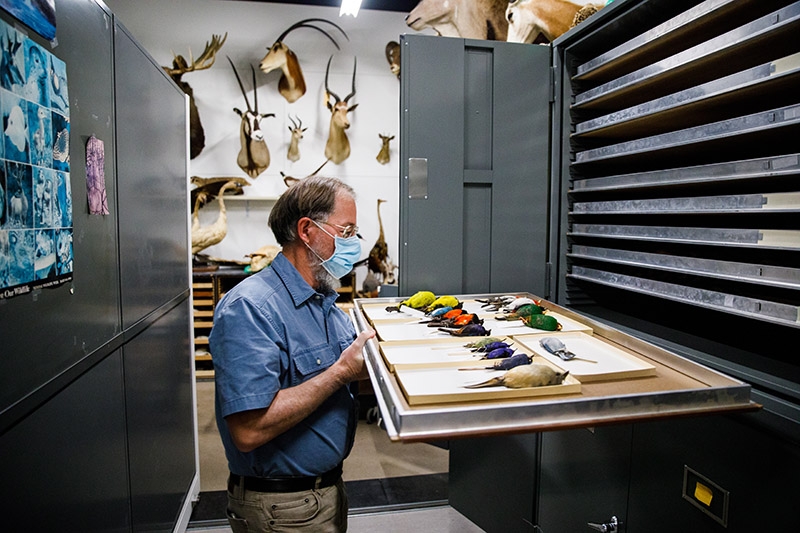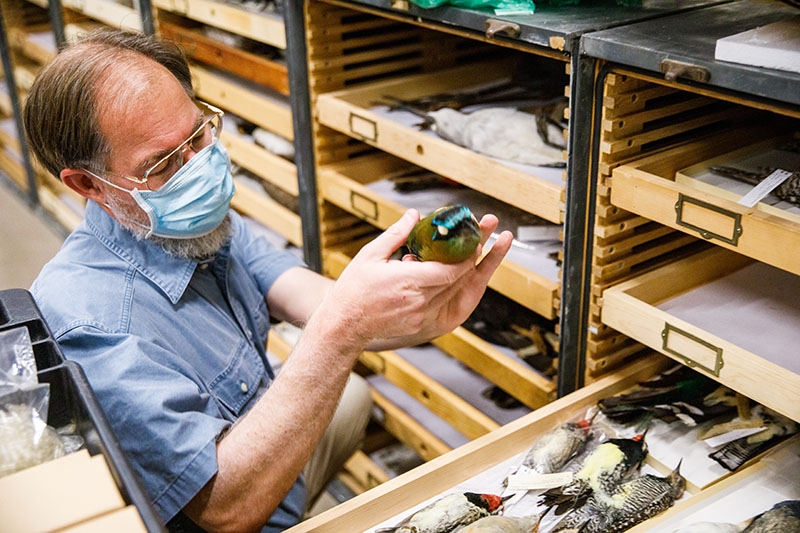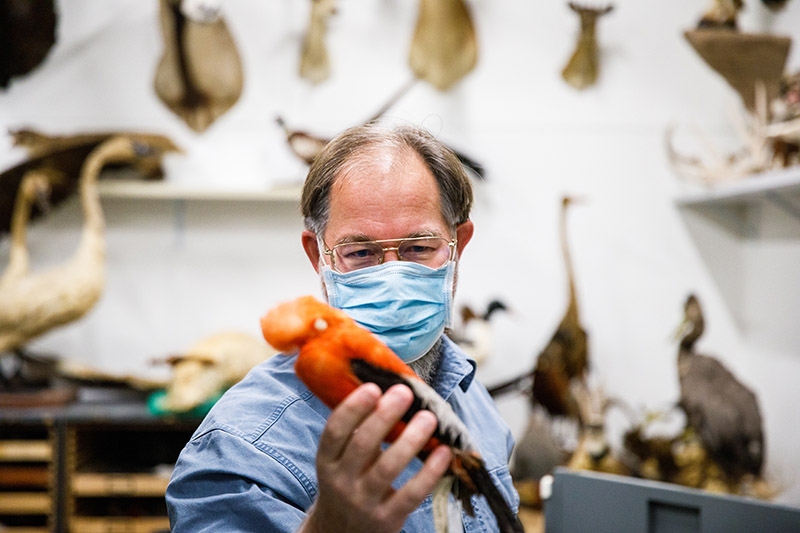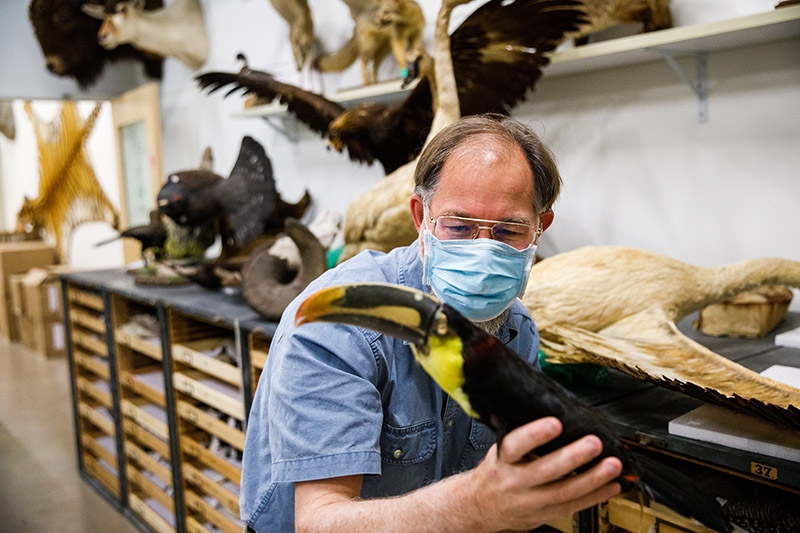The room is dark at first, but once the lights are on, you see birds — absolutely everywhere. Gleaming glass eyes stare down at you from across the room. A row of ducks, swans and pheasants sits atop a set of storage cabinets.
A golden eagle rests upon a stone near the doorway, as if it is just landing from a long flight, its wings stretched out, feet lightly touching the stone, frozen in time.
If you open a drawer to one of the many storage cabinets in the room, you’ll find that they too are filled with birds. Hundreds of bird skins — the term scientists use for stuffed birds with the original feathers, feet and beak — are lined up neatly in rows.
Where did they come from? How did they end up in this room?
This is no avian graveyard. Instead, this accumulation of birds represents Arizona State University’s Ornithology Collection, part of the Natural History Collections.
Until recently, these birds lay disorganized and mostly forgotten.
That changed when the collections team hired Dakota Rowsey, a collections manager for the Vertebrate Collections. Rowsey and Jay Taylor, an associate professor in the School of Life Sciences, have truly turned the Ornithology Collection around — though work still remains to be done.
Natural history collections are important for research institutions. A collection documents the species that existed in a particular place at a particular time. The Ornithology Collection is used for research, the education of ASU students and public engagement.

A tray of tanagers, colorful neotropical birds. These are from various countries in the Americas. Photo by Andy DeLisle/ASU
The Natural History Collections facility is a long beige building about 2 miles from ASU’s Tempe campus, so it’s not surprising that many students and community members don’t know that it exists. But it contains a treasure trove of scientific information. There are nine different collections in total — including the Mollusk Collection, Mammalogy Collection, Herpetology Collection, Ichthyology Collection, Fossil Plant Collection, Hasbrouck Insect Collection, Lichen Herbarium and the Vascular Plant Herbarium.
WATCH: Take a peek inside the ASU Natural History Collections
And of course, there is the Ornithology Collection. Currently, it contains over 1,400 skins from around 450 species belonging to 75 families. While birds from Arizona are particularly well-represented in the collection, there are also specimens from 26 U.S. states, as well as from Canada, Mexico, Ecuador, Samoa, Kiribati and Kazakhstan.
Taylor started his ASU career as a professor in the School of Mathematical and Statistical Sciences in 2009. He is an evolutionary biologist who uses modeling, statistical analysis and genetic data to understand how populations and communities evolve. His research focuses on soil mites. So his interest in birds might seem surprising.
“Why birds? It happened more or less accidentally. In between my undergrad and graduate years, I was living in Maryland, and one day found a dead pied-billed grebe in the parking lot where I was living. That discovery got me interested in birding, and I’ve been doing it ever since.”
LISTEN: The Lesson's motmot song

Taylor holds a Lesson's motmot. This bird skin was collected in Oaxaca, Mexico, in 1962. They are one of the most common and widespread motmot birds in Central America. Photo by Andy DeLisle/ASU
Five years ago, he was asked to teach an ornithology class at ASU, and that’s when he learned about the state of the bird collection.
“I was given a big crate that was basically a pile of bird skins (that) was being used as a teaching collection, and that wasn't very satisfactory,” says Taylor. “And so I started looking through the collection, and at that time, there were no written records. It was a mess. And so it was really because of that, that I started getting involved.”
The Ornithology Collection’s origins
How do birds come to be part of the Ornithology Collection? First, it’s important to note that the ASU team does not ever hunt or kill birds. Everything that comes into the collection is already deceased.
Much of the material in the Ornithology Collection was obtained prior to the 1980s, when there wasn’t as much regulation on collecting birds.
“The Migratory Bird Treaty Act of 2004 pretty much applies to all of our native migratory species, other than things like waterfowl or game birds that are managed for hunting. You can't just go out and hunt those — I mean, in principle, you're not even allowed to pick up feathers,” says Taylor. “We have salvage permits to collect dead birds — those that are window strikes, roadkill and the like.”
Before Taylor, very few people were involved directly with the Ornithology Collection.
“I don't even know who specifically started it. Someone who worked here perhaps in the 1950s contributed skins that they had somehow acquired prior to joining the university. Maybe they had them in their house for years before moving them here. We have no idea,” says Taylor.
What Taylor does know, however, is where about a third of the collection came from. Robert Ohmart was a professor in the ASU Department of Biology — as it was called then — from 1970 to 2006. As a graduate student, he prepared a number of skins that he brought with him to ASU. Additionally, a former student of his, Bertin Anderson, donated a large number of skins from birds that he collected in the Midwest.
Other specimens arrive through generous donations from the community.
“We received a truckload of material four years ago, which came from a hotel ... that had its own sort of natural history museum,” says Taylor.
The Buckhorn Baths Motel had a makeshift museum filled wall-to-wall with mounted animals of all kinds — from mounted deer to display cases of reptiles. The dusty animals were donated to ASU, and Taylor himself was one of the people to load the trucks with the sizable donations.
“The prep room here was filled with them for quite some time. The entire floor and tables were covered with this material. We did get some birds from them, but none of them had where the birds were from, which is really unfortunate,” says Taylor.
That golden eagle that sits near the doorway of the Ornithology Collection is just one of the specimens donated by the Buckhorn Baths Motel.
READ MORE: The Buckhorn Baths donation
The origins of the rest of the bird skins and prepared mounts, unfortunately, remain a mystery.
Pristine, pest-free and publicly accessible
A lot of care goes into preserving a collection of organic material. If future generations of scientists are to be able to use the specimens, they need to be pristine.
“You need to maintain them in a location that's not going to be too humid or dry, not too hot or too cold. And critically important — you need to keep it pest-free,” says Taylor.
For example, if a beetle that consumes dead tissues slips into a collection, it can destroy years of carefully curated material.
Whenever something new comes into the collection, the staff must freeze it first. By freezing the specimens, they kill any pests long before they can be introduced to the clean skins.
Organizing the specimens is also important so that researchers and educators can find what they need easily.
LISTEN: The Andean cock-of-the-rock's song

Taylor holds a male Andean cock-of-the-rock, named for its similarity to roosters and its habitat of rocky cliffs and ravines. This bright orange bird has unknown origins but is likely from Ecuador. Photo by Andy DeLisle/ASU
When a collection is digitized, the information it contains is put into an online database. Information about the birds in the Ornithology Collection can be searched for and openly accessed through the Consortium of Small Vertebrate Collections.
Savage Hess, a student worker on the collections team, has done a significant amount of the organizing and digitizing himself.
“After burning through the roughly 1,400 specimens, each held by me at some point or another, I held the responsibility of labeling our cabinets according to their evolutionary relationships,” says Hess. “It was also up to me to search through our digital records and place the birds into their relevant homes, creating something of a checklist of specimens.”
The digitized collection is organized in such a way that if someone wants to know where a particular bird is located in the physical collection, they can find that information online, as well as information about where and when the bird was found, its sex, general age and physical state upon death.
It is no easy task to organize a collection of specimens — especially when they have lacked real organization for decades.
“It was long and tedious, but one of the most satisfying experiences in my life,” says Hess.
The number of specimens might not grow significantly, but the collections staff feels it’s more important to increase the awareness of the Ornithology Collection.
“Nobody has really made specific use of the bird collection, at least when compared to the other collections in the building. It’s newly digitized, so that’s part of it. But a lot of people simply don’t know it’s here,” says Taylor.
There’s a lot you can do with the collection
The ornithology class that Taylor teaches is one way to get ASU students more involved with the collection. As part of the course, students get the opportunity to look at various specimens from the collection each week. Rather than learning about different species of birds through photos alone, they are able to hold them and look at their features up close.
People from other institutions can also use the digitized collection online or visit the facility to measure and photograph the specimens and compare them with collections at different institutions around the world.
By studying the skins, researchers can understand the differences in male and female birds, as well as regional variation in various bird species. They can use the skins to measure characteristics like bill size or depth, relative proportions and colors of the feathers.
Researchers can even extract DNA from the specimens, which could provide more information on regional variation and the genetic composition of populations, and help scientists define subspecies with greater accuracy.
All of this information is crucial in allowing us to see the human impact on bird populations. By comparing birds that lived decades ago to those alive today, we can better understand how climate change and environmental degradation are affecting bird species around the world.
If we narrow in on a specific species and track its changes over time, we can then see how species adapt to those changing environments.
LISTEN: The keel-billed toucan's song

Taylor holds a keel-billed toucan, a colorful Latin American member of the toucan family. Photo by Andy DeLisle/ASU
With the Ornithology Collection almost fully digitized, it’s more accessible for faculty and students at ASU, as well as other universities and the public as a whole.
And it is already being used for outreach. A few years back, the Phoenix Sky Harbor International Airport borrowed some more exotic specimens to set up a tropical display. The community can also see the Ornithology Collection, as well as the other collections, at ASU’s annual Open Door event.
A lot of collections in other institutions exist primarily for research. The public isn’t involved at all. But a rarity like the collections at ASU has a lot more to offer. Involving the public can spark interest in science and conservation, and maybe even inspire a new generation of researchers.
Taylor and his collections colleagues also want to increase ASU student involvement.
“We're certainly very interested in having students work out here. There are a lot of opportunities for undergraduates and graduate students to work in the collection if they're interested. Not just the bird collection, but all of the collections,” says Taylor.
Interested in getting involved in the collections? Visit the Biodiversity Knowledge Integration Center to learn more about how they use their collections for research and education. You can also email Nico.Franz@asu.edu to request information.
If you happen to come across a deceased bird, email the location of the bird and a photo to Jesse.E.Taylor@asu.edu.
Identify a bird in the wild by its appearance, calls or song using the Bird Finder on ASU’s Ask A Biologist site.
Written by Elise Lange
More Science and technology

Ancient sea creatures offer fresh insights into cancer
Sponges are among the oldest animals on Earth, dating back at least 600 million years. Comprising thousands of species, some with lifespans of up to 10,000 years, they are a biological enigma.…

When is a tomato more than a tomato? Crow guides class to a wider view of technology
How is a tomato a type of technology?Arizona State University President Michael Crow stood in front of a classroom full of students, holding up a tomato.“This object does not exist in nature,” he…

Student exploring how AI can assist people with vision loss
Partial vision loss can make life challenging for more than 6 million Americans. People with visual disabilities that can’t be remedied with glasses or contacts can sometimes struggle to safely…
